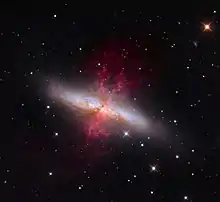Galactic superwind
A galactic superwind, or just galactic wind, is a high velocity stellar wind emanating from either newly formed massive stars, spiral density waves, or as the result of the effects of supermassive black holes.[2] They are normally observed in starburst galaxies.[3][4]
Description
Galactic winds are strong stellar winds made up of charged particles, ejecta, and varying amounts of hot and cool gas, interacting with enough force that the ejecta's kinetic energy is converted to thermal energy.[5][6] The resulting effect is a massive gust of rapidly expanding super-heated gases that can span the length of a galaxy.[3][7] In galaxies with active galactic nuclei, galactic winds can also be driven by the effects of super-massive black holes.[2]
Galactic winds are considered an important function in the evolution of a galaxy.[5][8][2] The winds cause an outflow of gas and other materiel into the halo of a galaxy, while also facilitating the spread of metals around a galaxy.[2] Galactic winds are also capable of blowing material out of a galaxy entirely and into the intergalactic medium.[2][5]
Formation
Superwinds are theorized to form in compact starburst galaxies in which star growth is much higher than in other types of galaxies. This accelerated star growth results in more prevalent stellar winds being present in starburst galaxies. Superwinds form when ejecta released either by supernovae or stellar winds collide with such force that the shock from the impact converts the kinetic energy of the ejecta into thermal energy. The violent conversion from kinetic to thermal energy prevents a significant amount of energy from being radiated away. This in turn creates an incredibly hot bubble of gas that is under much greater pressure than it surroundings are. Eventually the gas bubble will expand to encompass other particles of ejected gases, further increasing the force and size of its expansion. This "snowplow" effect results in a gust of stellar wind and gas that can span the width of a galaxy.[3] It has been theorized that superwinds can potentially be traveling at a velocity of several thousand kilometers per second by the time they enter the intergalactic medium.[3]
See also
References
- Lehnert, Matthew D.; Heckman, Timothy M.; Weaver, Kimberly A. (1999-10-01). "Very Extended X-Ray and Halpha Emission in M82: Implications for the Superwind Phenomenon". The Astrophysical Journal. 523 (2): 575–584. arXiv:astro-ph/9904227. Bibcode:1999ApJ...523..575L. doi:10.1086/307762. ISSN 0004-637X. S2CID 18155360.
- "Galactic Winds | COSMOS". astronomy.swin.edu.au. Retrieved 2018-03-01.
- "Galactic Superwinds - T.M. Heckman et al". ned.ipac.caltech.edu. Retrieved 2017-12-14.
- "The Superwind Galaxy NGC 4666". www.eso.org. Retrieved 2017-12-14.
- "Galactic Winds | UW-Madison Astronomy". www.astro.wisc.edu. Retrieved 2018-03-01.
- "Galactic Winds - S. Veilleux et al". ned.ipac.caltech.edu. Retrieved 2018-03-01.
- Heckman, Timothy (2000-07-15). "The role of starbursts in the formation of galaxies and active galactic nuclei". Philosophical Transactions of the Royal Society of London A: Mathematical, Physical and Engineering Sciences. 358 (1772): 2077–2091. arXiv:astro-ph/9912029. Bibcode:2000RSPTA.358.2077H. doi:10.1098/rsta.2000.0631. ISSN 1364-503X. S2CID 12888083.
- Heckman, Timothy M.; Thompson, Todd A. (2017). "Galactic Winds and the Role Played by Massive Stars". Handbook of Supernovae. Springer, Cham. pp. 2431–2454. arXiv:1701.09062v1. doi:10.1007/978-3-319-21846-5_23. ISBN 9783319218458. S2CID 125856372.
